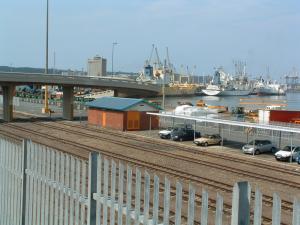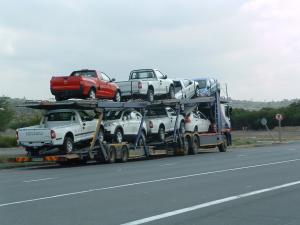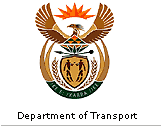 |
Automotive and Machinery ManufacturersThe automotive industry in KwaZulu-Natal is an important
sector of the South African motor manufacturing
industry. There are eight local producers of light motor
vehicles in South Africa, (of which one of the biggest is
located in KZN), as well as two producers of medium and
heavy vehicles.
The South African auto industry is relatively small by
world standards with 200 firms employing 38,000 workers.
The industry is complicated by the fact that distribution
chains exist for more than thirty different makes of motor
cars and commercial vehicles, far in excess of the numbers
available in Europe or America, and imported built-up
vehicles are often cheaper than local production.
Imports and exports through the car terminal in Durban
amounted to about 213,000 in 2005 but are projected to
rise to 389,000 by 2020. The port of Durban reported car
imports and exports at more than 1.0 million tons in each
direction in 2006.
All South African equipment manufacturers and assemblers
are subsidiaries of international concerns which
rationalise their production in all countries to suit
their
corporate strategies. The opportunity for KwaZulu-Natal
are to manufacture is limited both by
the extent of the South African market and by
the cost of the input factors and materials such as
steel, stainless, platinum and labour, which dictates the
relevant competitiveness of South African
manufacturers compared to other international sources.

Automobile Manufacturer
|
A current concern is the tendency for South African
suppliers of materials to practice “import parity
pricing”
which is eroding the competitiveness of the SA auto
manufacturing sector.
Increasing wage costs in excess of those experienced in
Europe and the Far Eastern countries will also have
negative impacts on the future expansion of the industry.
Efficient transport services are crucial to the success of
automotive manufacturing in KwaZulu-Natal, with large
proportions of many of the vehicles that are assembled in
SA being transported in containers by rail as CKD
[crated, knocked down] kits. In addition, most South
African export components and built-up vehicles from
inland manufacturers are transported in containers by
road and rail to the ports.
Logistics costs is a concern for South African
manufacturers, and for KwaZulu-Natal manufacturers in
particular, due to the long distances to foreign markets
and for the supply of input materials from the major
manufacturing regions in Europe and the Far East. In order to minimise logistics costs, there is an
imperative logic for the centralisation of manufacturing
facilities for vehicles and components to reduce transfer
costs between component and vehicle manufacturers. The
efficiency of the entire logistics chain is also crucial
to the success of the
industry. Current problems with rail transport have led
some manufacturers to switch entirely to road. These
imported vehicles are efficiently
transported on large, purpose-built car carrier
vessels, and pose a major threat to the future of the
South
African industry. This is aggravated by the large numbers
of second-hand vehicles that are available in several
overseas countries and are currently sold into Africa,
passing through South Africa in bond and effectively
eroding the potential markets for South Africa’s
vehicle manufacturing industry in neighbouring countries. Heavy VehiclesThere are two main assemblers of heavy commercial
vehicles in KZN, both located in the Durban area.

Car terminal berths R and S with vehicles on quay
|
Automotive Parts And ComponentsThe automotive parts and components industry in KwaZulu-
Natal consists of approximately 100 firms, employing
18,000
workers, and contributes an estimated 1.3% to the
province's gross geographic product. The industry produces
a wide range of components for the OEM market and the
after-sales spare parts market. Products include glass,
brake components, looms, hoses and piping, rims, springs,
exhausts, pressings and castings, and belts and
accessories.
The motor industry development programme (MIDP) has been
in existence for a number of years, providing the
framework of government policy within which the automotive
sector can rationalise its imports, exports and local
production. The MIDP attempts to rationalise the number
of
models assembled locally and to increase exports of fully
assembled vehicles and components.
The MIDP as currently structured is scheduled to continue
until 2007. In view of the long product development
cycles in the auto industry, current uncertainty on the
official future policy position is a possible deterrent
to expansion. Other ManufacturersRichards Bay has the largest manufacturer of South African-
made earth moving and handling equipment. The components
for the machines are sourced from a number of different
factories in the Durban area, and power and transmission
units are imported via the port of Durban.
The plant produces more than 2200 machines per year as
well
as components for the after-sales market. The various
models include trucks, loaders, haulage tractors, front-
end
loaders and tractor-loader-backhoes [TLBs].
Machines are sold all over South Africa and Africa, and
are exported to USA, Australasia, the Far East and
Europe through the port of Durban. Transport Usage in the Automotive IndustryThe use of international air transport for emergency
imports of components amounted to approximately 6000 tons
in 2002, whilst exports amounted to 3000 tons for the same
year.
The usage of road and rail by the automotive manufacturing
industry, although complex and extensive, does not amount
to significant tonnages overall.
Most of the fully built-up motor vehicles transported in
South Africa now move by road on specialised vehicle
carriers. The car transporters have sophisticated
networks of vehicles transporting between Port Elizabeth
and Durban from manufacturers and ports to the interior,
and back-hauling vehicles produced inland for export
and coastal distribution.
The estimated total tonnage (including the use of
stillages, racks, cradles and
packaging), moved for the
industry is 1.4 million tons per annum for
the 880 000 vehicles produced. Of this volume, an
estimated 25% (or 350,000 tons p.a.) is transported in
KZN.

Car Carriers
|
|
 |



